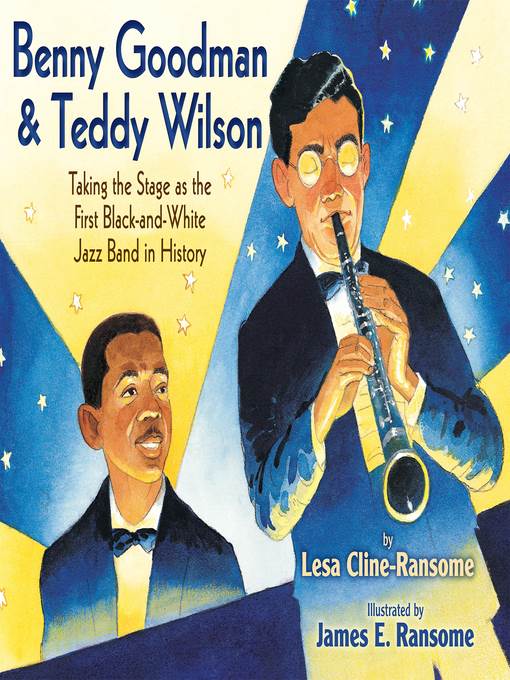
Benny Goodman & Teddy Wilson
Taking the Stage as the First Black-and-White Jazz Band in History
فرمت کتاب
ebook
تاریخ انتشار
2014
Reading Level
3-4
ATOS
5
Interest Level
K-3(LG)
نویسنده
James E. Ransomeناشر
Holiday Houseشابک
9780823431410
کتاب های مرتبط
- اطلاعات
- نقد و بررسی
- دیدگاه کاربران
نقد و بررسی

January 27, 2014
In 1936, the Benny Goodman Trio became the first interracial band to perform in public, with Benny Goodman (the son of Jewish immigrants) on clarinet and African-American Teddy Wilson on piano (Gene Krupa, on drums, completed the trio). Writing in punchy free verse that echoes the bounce of both men’s music, Cline-Ransome traces Goodman and Wilson’s parallel—but separate—paths to jazz fame, before eventually meeting in 1935. Working in watercolor outlined in loose pencil, Ransome strongly evokes the allure of music that Goodman and Wilson both felt as boys, as well as way jazz all but demanded people get up and move: “The stage was hot/ The dancer floor was hotter/ The music was hottest.” Ages 8–12.

March 15, 2014
This married author-illustrator team (Light in the Darkness, 2013, etc.) here highlights the innovative, barrier-breaking collaboration of African-American Wilson and Jewish-American Goodman. Cline-Ransome's staccato verse narrative articulates the musicians' parallel paths to their eventual collaboration. She contrasts their backgrounds, describing dedicated musical training, early jazz influences and stints in various bands. (Wilson, the son of Tuskegee educators, studied music theory in college in Alabama, while Goodman got free synagogue music lessons and gigged around Chicago, quitting school at 14.) The two are introduced in Queens, N.Y., in 1935 and click during an impromptu jam. Benny forms a trio with Wilson and drummer Gene Krupa, overcoming--in April 1936 in Chicago--an initial reluctance to appear with Wilson, making them the first interracial band to perform in public. That same year, vibraphonist Lionel Hampton joins up, making it a quartet. Ransome's watercolors utilize a palette rich in twilight-blue, indigo and yellow, punctuated with sienna, red and green. In lively double-page spreads, he captures the band's dedication to practicing and recording together, as well as the verve and excitement of their live shows. Two pages of background notes include more about the musicians, a timeline of jazz events and a brief "Who's Who" of some of jazz's giants. A solid exploration of a resonant musical partnership at a historically significant moment in American music. (Informational picture book. 6-9)
COPYRIGHT(2014) Kirkus Reviews, ALL RIGHTS RESERVED.

March 1, 2014
Gr 2-6-The true story of jazz musicians Benny Goodman and Teddy Wilson is told in deep blues and gold with splashes of red throughout. The lyrical prose infuses the book with the spirit of jazz ("Benny blowing /bleating /breathing /music /into Benny's clarinet.") The illustrations are realistic and reminiscent of Jerry Pinkney's God Bless the Child (HarperCollins, 2003), yet the watercolors seem to blur together at times and swing like the music that Teddy and Benny play. The biographical back matter will give readers more insight into all of the musicians mentioned and shed light on how a love of music helped the two break down color lines.-Krishna Grady, Darien Library, CT
Copyright 2014 School Library Journal, LLC Used with permission.

June 1, 2014
Grades 2-4 While a young Benny Goodman was growing up on the West Side of Chicago during the Roaring Twenties, Teddy Wilson was in Alabama, listening to Fats Waller. Music was a part of both boys' lives: Benny played the clarinet; Teddy was a piano player. This title tells their stories on alternating pages until they meet in New York City. Benny's clarinet is blowing all sweet / all dance / all white. Teddy's playing is all hot / all rhythm / all black. Initially, the duo jams and cuts records, but the musicians don't play together onstage: Audiences weren't ready for a black-and-white band. The endnotes tell a different story: it was Goodman, worried about his career, who didn't want to go onstage with Wilson until disappointed audiences walked out. Nevertheless, this introduces an important event in a snappy text that swings. Ransome's line-and-watercolor pictures also flow with movement and color. Kids drawn in by the story of the young artists will go on to ponder the history.(Reprinted with permission of Booklist, copyright 2014, American Library Association.)

























دیدگاه کاربران